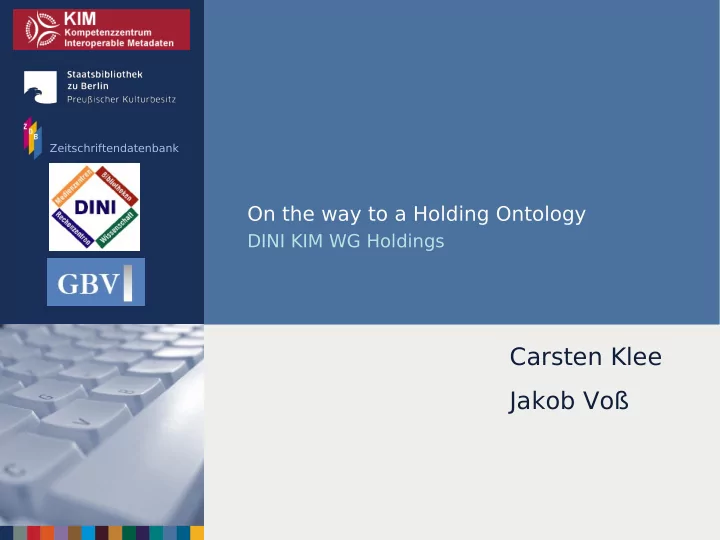

Zeitschriftendatenbank On the way to a Holding Ontology DINI KIM WG Holdings Carsten Klee Jakob Voß
Cow path is paved More & more RDF data from libraries and related Zeitschriften- datenbank organizations Good guidelines (W3C LLD, Working Group Titles best practice guide, LLD Book) ..but no descriptions of holding
Why holdings? Use cases Zeitschriften- datenbank Final Report 25 October 2011 (W3C LLD Incubator Group) Open Bibliographic Data Guide (JISC / UK RDTF)
Use case 1 & 2 The supply of records containing holdings data to a shared service Zeitschriften- datenbank 1. in order to support collection management. 2. in order to enhance discovery, location and delivery services.
Use case 3 & 4 3. Expose bibliographic data including holdings and potentially Zeitschriften- datenbank availability that can be used to provide a closest copy location service. 4. Creating the opportunity for third parties to develop local and wider services of value some of which may potentially drive increased attention and traffic back to the library and its holdings. By MJ Suhonos - MyTPL iPhone App
Use case 5 5. Search engines having greater knowledge of institutional Zeitschriften- datenbank holdings
Working Group Holdings founded in April 2013 Zeitschriften- datenbank Mailinglist dini-ag-kim-bestandsdaten@lists.dnb.de Wiki https://wiki.dnb.de/x/johZB GitHub https://github.com/organizations/dini-ag-kim/teams/448741 Discussion in English
What are our goals? Best Practice Guide Zeitschriften- datenbank how to publish holding data in RDF reuse of existing vocabularies examples and mappings based on existing data and formats (MARC, PICA)
Analysis of Standards/Formats related to holdings Standards/Formats Zeitschriften- datenbank ISO 20775 ISO 18626 Interlibrary Loan Transactions Holdings Statements for Bibliographic Items Z39.71-2006 MARC21 Holdings ZETA
Analysis of Ontologies and Vocabularies related to holdings Zeitschriften- datenbank Ontologies/Vocabularies Document Availability Information API (DAIA) Document Service Ontology (DSO) Simple Service Status Ontology (SSSO) Enumeration and Chronology of Periodicals Ontology (ECPO) Bibframe Holding Vocabulary ONIX-SOH Serials Online Holdings ONIX for Serials Coverage Statement Interlibrary loan code GLAM Item Ontology Library Holdings RDF Vocabulary Erlangen CRM DC Terms, FOAF, Good Relations etc.
What hinders you from contributing to the holdings group? Github is a hurdle Discussion level to high Zeitschriften- datenbank Within discussion I don't feel addressed Unprofessional group management Other reasons Working status unknown/unclear I intended to be a passive reader English is a hurdle 0 1 2 3 4 Votes 90 postings by 9 of 36 subscribers since April
And now? You are welcome to contribute to the group! Zeitschriften- via datenbank http://lists.dnb.de/mailman/listinfo/dini-ag-kim- bestandsdaten or https://github.com/dini-ag-kim/holding-ontology - is your data covered by the Holding Ontology? - provide RDF examples https://github.com/dini-ag-kim/holding-ontology-examples
What kind of holding data? Holding Ontology should enable to clearly answer: 1. What holdings does a library have? 2. What documents are included in or exemplified by a holding? 3. What can patrons do with a holding? 4. Where is a holding located? 5. What are unique properties of a holding? 6. What is a patron doing with a holding? ◮ Clarify fuzzy terms terms such as holding , document , copy , item , piece , copy , . . .
Core Concepts (1/2) Why create new RDF classes? Reuse existing ones! frbr:Item an exemplar/copy of a document (aka holding ) bibo:Document = foaf:Document an abstract or concrete work which an frbr:Item is exemplar of foaf:Agent a person or organization (a library, a patron. . . ) schema:Place = gr:Location a place or location (a library building, a floor, a stack. . . )
Core Concepts (2/2) Why put everything in one ontology? Create micro-ontologies! dso:DocumentService a service that includes a document (lending, accessing, copying. . . ) ssso:ServiceEvent a service that is also an event (e.g. lending of item X by patron Y during time Z) ecpo:Chronology enumerations and chronology of a periodical or series (e.g. volume 5, issue 3 till now) Here “a service that” refers to service:Service defined in the Service Ontology to describe services both abstract and concrete.
Micro-Ontologies (classes/properties/individuals) ◮ Service Ontology (4/8/0) http://dini-ag-kim.github.io/service-ontology/ ◮ Document Service Ontology (DSO) (5/2/0) http://purl.org/ontology/dso ◮ Simple Service Status Ontology (SSSO) (8/2/0) http://purl.org/ontology/ssso ◮ Holding Ontology (0/10/0) http://dini-ag-kim.github.io/holding-ontology/ ◮ Enumeration and Chronology of Periodicals Ontology (ECPO) (3/29/2) http://purl.org/ontology/ecpo ◮ DAIA Ontology (DAIA) (0/4/0) http://gbv.github.io/daiaspec ◮ PAIA Ontology (PAIA) (2/1/2) http://purl.org/ontology/paia
What kind of holding data? (1/2) 1. What holdings does a library have? ◮ $library a foaf:Agent ; holding:holds [ a frbr:Item ] . ◮ This alone does not imply services (see 3.) 2. What documents are included/exemplified by a holding? ◮ $holding a frbr:Item; holding:exemplar [ a bibo:Document ] . ◮ $holding a frbr:Item; ecpo:hasChronolgy [ a ecpo:Chronology ]. ◮ Part/whole relationships: dcterms:hasPart , holding:narrowerExemplar . . . 3. What can patrons do with a holding? Services and Offerings that include holding items ( daia:availableFor , service:providedBy . . . )
What kind of holding data? (1/2) 4. Where is a holding located? ◮ $holding a frbr:Item ; schema:location $place ; holding:inCollection $col . ◮ $o a schema:Offer ; gr:includesObject $holding ; schema:availableAtOrFrom $place . ◮ . . . ? 5. What are unique properties of a holding? holding:label (aka call number, shelf mark. . . ) 6. What is a patron doing with a holding? holdings currently on loan or reserved expressible with PAIA ontology and Simple Service Status Ontology.
Summary The holding ontology combines ◮ existing ontologies (BibO, FOAF, GoodRelations, Schema.org) ◮ new micro-ontologies (DSO, SSSO, ECPO, DAIA, Service) ◮ and a couple of holding ontology properties to all RDF terms required to describe holding information. work in progress, feedback welcome! https://github.com/dini-ag-kim/holding-ontology
Recommend
More recommend